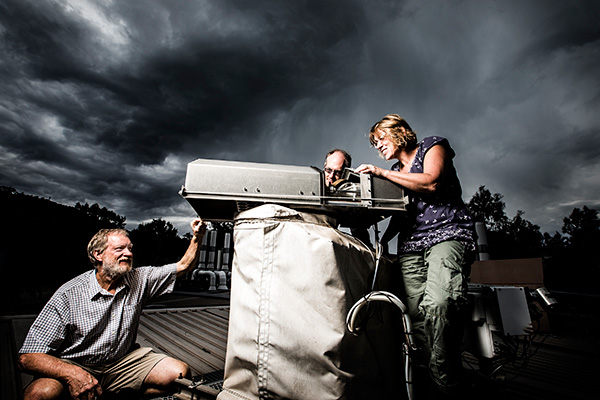November 5, 2014
New report finds ozone-depleting chemical is on the rise
The abundance of an ozone-damaging, chlorine-containing gas in the Earth’s atmosphere is on the rise.

From left: Professor David Griffith, Dr Nicholas Jones and Dr Clare Murphy, from UOW's Centre for Atmospheric Chemistry, with the equipment they use to monitor air pollution and the ozone.
A report published in Nature today (6 November), authored by an international team of scientists, including three atmospheric chemists from UOW, found an unexpected increase in the amount of hydrogen chloride in the Northern hemisphere stratosphere since 2007. Hydrogen chloride releases chlorine in the startosphere, leading directly to ozone depletion.
Professor David Griffith, Director of UOW’s Centre for Atmospheric Chemistry, who co-authored the report, said the increase is a result of a temporary but prolonged anomaly in atmospheric circulation.
The findings are based on measurements by a network with ground-based remote sensing stations at a number of locations around the world, including one at UOW, which has been in operation since 1996.
Professor Griffith, in conjunction with his colleagues at UOW, Dr Nicholas Jones and Dr Clare Murphy, analysed these measurements, which when combined with satellite observations and model simulations led to the conclusion that while the chlorine concentrations in the Northern hemisphere are on the rise, those in the Southern Hemisphere are continuing to decrease, as expected in line with the Montreal Protocol.
However, they warned that the recovery of ozone-depleting chemicals in the atmosphere is a slow process and will take many decades.
“During this time the ozone layer remains vulnerable,” Professor Griffith said.
The Montreal Protocol is an international treaty for the protection of the ozone layer that banned the production of major ozone-depleting substances worldwide. The large ozone loss over Antarctica was the key observation that stimulated its definition and signing in 1987.
Professor Griffith said the paper dismissed the possibility that rogue emissions of ozone-depleting substances are at play.
“The study confirms that the Montreal Protocol remains a success and that the ozone layer is likely to fully recover during the second half of this century. However, our results show that atmospheric variability and perhaps climate change can significantly modify the path towards full recovery. It will be a bumpy ride rather than a smooth evolution,” he said.
Note to media: High-resolution images are available from http://bit.ly/uownaturepaper. A copy of the paper is also available on request.
Media contact: Elise Pitt, Media & PR Officer, +61 2 4221 3079, +61 422 959 953, epitt@uow.edu.au.
Background information: The ozone layer in the upper atmosphere (stratosphere) shields the biosphere from harmful UV radiation and is an essential part of the climate system. Solving the problem of ozone depletion depends on the success of the Montreal Protocol, which has essentially banned the production of chlorofluorocarbons (CFCs) and similar compounds globally. These substances are the source of the chlorine responsible for most of the ozone depletion observed over the last 30 years. As a direct result of the Montreal Protocol their atmospheric burden has decreased during the last decade and scientists are optimistic that ozone levels will fully recover during the second half of this century.
In the stratosphere – the atmospheric layer between about 15-45 km altitude – CFCs break up and release chlorine atoms. Chemical processes in polar winter release the chlorine atoms from the stratosphere, which then destroy ozone in polar spring.